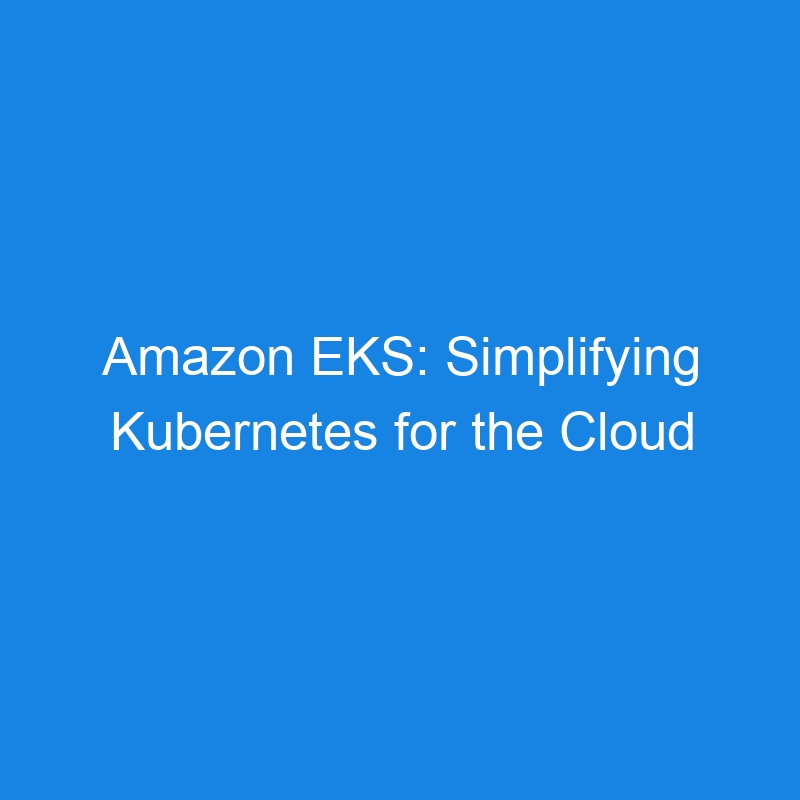Kubernetes has become the de facto standard for container orchestration, enabling developers and organizations to manage, scale, and deploy applications seamlessly. However, managing Kubernetes clusters can be complex, requiring a deep understanding of its components and significant operational overhead. This is where Amazon Elastic Kubernetes Service (EKS) comes into play, simplifying Kubernetes management and enabling teams to focus on building and running their applications.
What is Amazon EKS?
Amazon EKS is a managed Kubernetes service provided by AWS that makes it easy to run Kubernetes on AWS without needing to install and operate your own Kubernetes control plane or nodes. With EKS, AWS handles the complexity of managing the Kubernetes control plane, including scalability, availability, and security, so you can concentrate on deploying and managing your applications.
Why Use Amazon EKS?
1. Managed Control Plane
EKS provides a fully managed control plane that is highly available and automatically scaled across multiple AWS Availability Zones. AWS takes care of patching, upgrades, and monitoring, ensuring your Kubernetes cluster is reliable and up-to-date.
2. Seamless Integration with AWS Services
EKS integrates seamlessly with other AWS services, such as IAM for access control, Elastic Load Balancing for traffic distribution, CloudWatch for logging and monitoring, and AWS Fargate for serverless compute. This integration provides a robust ecosystem to build and manage cloud-native applications.
3. Security and Compliance
Amazon EKS provides built-in security features such as encryption of Kubernetes Secrets, IAM Roles for Service Accounts (IRSA), and compliance with standards like ISO, SOC, and PCI. AWS also ensures the control plane runs in an isolated environment to enhance security.
4. Flexibility and Scalability
EKS supports a wide range of workloads and configurations, from small development environments to large-scale production systems. It allows you to scale applications dynamically using Kubernetes-native tools like the Horizontal Pod Autoscaler (HPA) or AWS Auto Scaling Groups.
5. Multi-Platform Support
EKS can run on AWS and on-premises using Amazon EKS Anywhere, or in hybrid setups using AWS Outposts. This flexibility allows organizations to maintain consistency across environments.
Key Features of Amazon EKS
-
Fargate Support: Run Kubernetes pods without managing EC2 instances, providing a serverless compute option for your applications.
-
Spot Instances: Reduce costs by running non-critical workloads on spare EC2 capacity.
-
EKS Add-ons: Install and manage essential Kubernetes operational software, such as CoreDNS, kube-proxy, and the Amazon VPC CNI plugin, directly from the EKS console.
-
GitOps Support: Use tools like Flux or ArgoCD to enable continuous deployment workflows for your applications.
-
Karpenter: AWS’s open-source Kubernetes cluster autoscaler simplifies infrastructure scaling by optimizing node provisioning.
Getting Started with Amazon EKS
Here is a step-by-step guide to setting up an Amazon EKS cluster:
Step 1: Create an EKS Cluster
-
Use the AWS Management Console, AWS CLI, or Infrastructure as Code tools like Terraform to create an EKS cluster.
-
Define your cluster name, Kubernetes version, and networking configuration.
Step 2: Configure Networking
-
Set up an Amazon VPC with subnets and security groups to enable communication between Kubernetes components.
-
Configure IAM roles and policies for the cluster and worker nodes.
Step 3: Provision Worker Nodes
-
Launch worker nodes using Amazon EC2 or opt for AWS Fargate for serverless compute.
-
Attach the nodes to your EKS cluster by configuring the kubelet.
Step 4: Deploy Applications
-
Use
kubectlto deploy Kubernetes manifests (e.g., Deployment, Service, ConfigMap). -
Monitor workloads using Kubernetes-native tools and AWS integrations like CloudWatch.
Step 5: Monitor and Scale
-
Utilize CloudWatch metrics and Kubernetes autoscaling features to monitor and optimize your applications.
-
Implement HPA or Cluster Autoscaler to dynamically manage resource allocation.
Use Cases for Amazon EKS
-
Microservices: Manage microservices architectures with scalability and resilience.
-
CI/CD Pipelines: Automate build, test, and deployment workflows using Kubernetes and AWS tools like CodePipeline.
-
Machine Learning: Run ML workloads efficiently with Kubernetes-based frameworks like Kubeflow.
-
Hybrid Deployments: Use EKS Anywhere to run consistent Kubernetes environments across cloud and on-premises.
-
Gaming and Media Streaming: Leverage the scalability of EKS for real-time multiplayer gaming or high-quality media streaming.
Best Practices for Amazon EKS
-
Secure Access: Use IAM and RBAC policies to control access to your cluster.
-
Optimize Costs: Utilize Spot Instances and Fargate for cost-effective compute.
-
Monitor Clusters: Implement observability tools like Prometheus and Grafana alongside AWS CloudWatch.
-
Automate Deployments: Use CI/CD pipelines with GitOps or Kubernetes-native tools.
-
Stay Updated: Regularly update Kubernetes and EKS add-ons to leverage the latest features and security patches.
Conclusion
Amazon EKS simplifies the operational complexity of managing Kubernetes, allowing developers to focus on delivering innovative applications. With its seamless integration with AWS services, robust security, and flexibility to support diverse workloads, EKS is an ideal choice for teams looking to scale their containerized applications in the cloud.
Whether you are a startup experimenting with Kubernetes or an enterprise running mission-critical workloads, Amazon EKS provides the tools and ecosystem you need to succeed in your cloud-native journey. So why wait? Start exploring Amazon EKS today and unlock the potential of Kubernetes on AWS.
